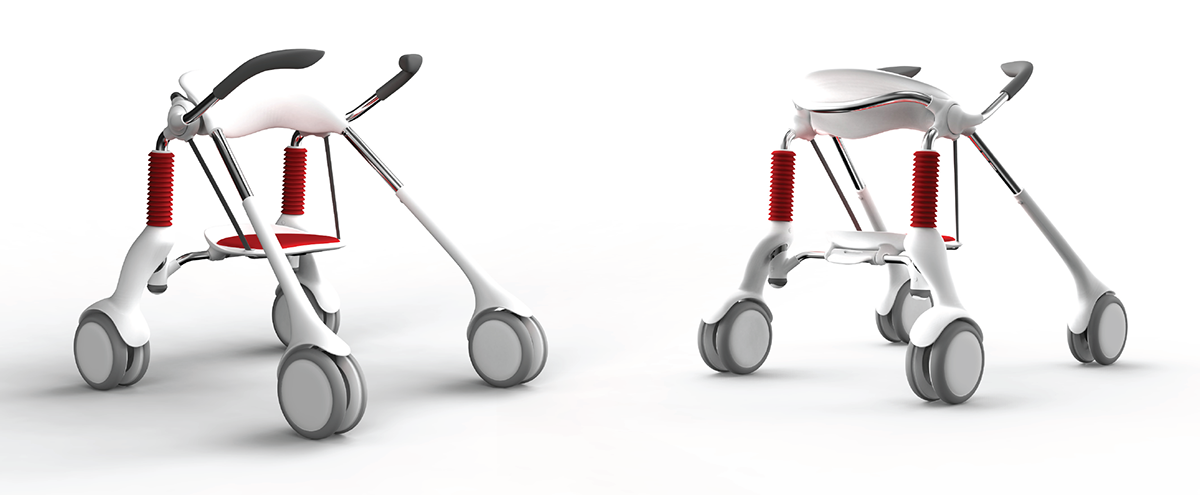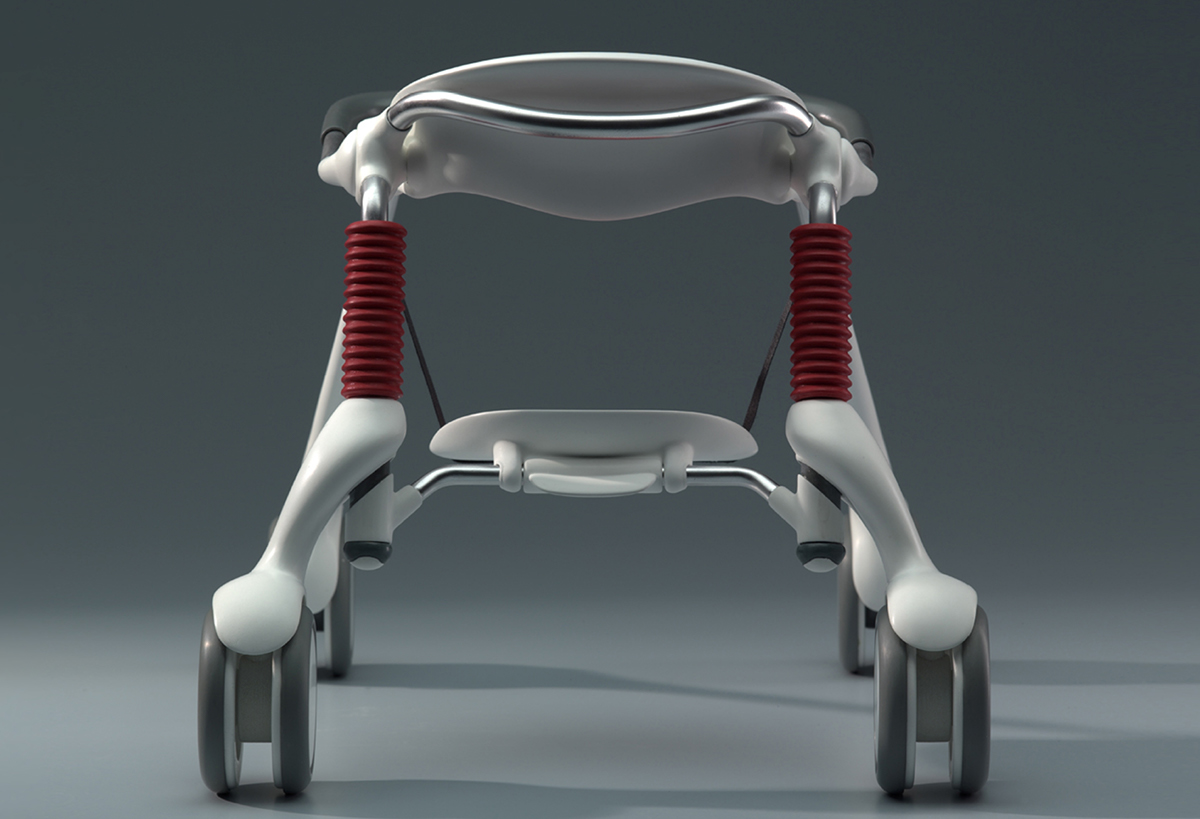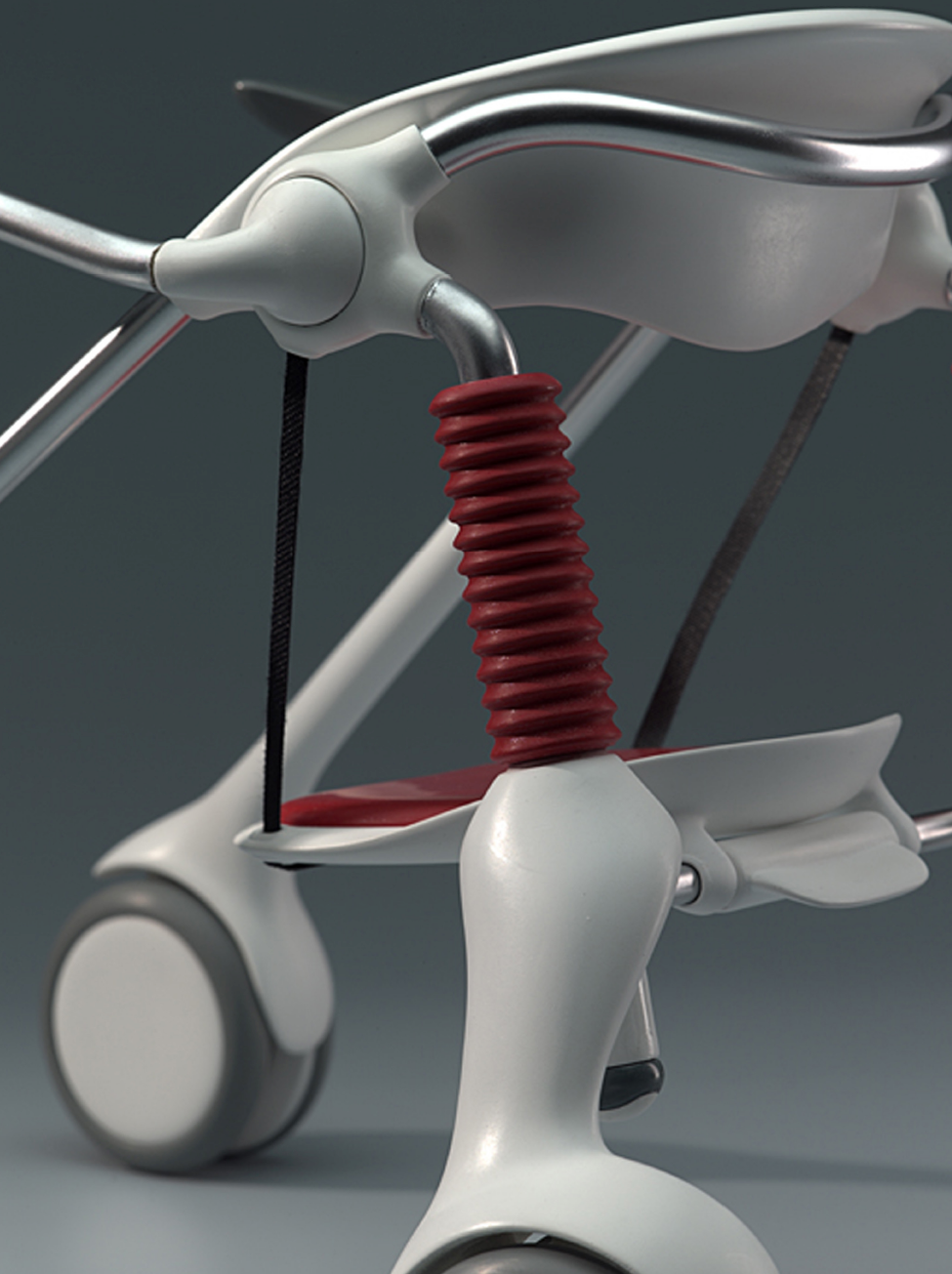
Leapfrog Assistive Walker for Children with Cerebral Palsy or Spina Bifida
The Problems

Caregiver Burn Out = Insufficient Practice for Child at Home

Poor Sense of Emotional Independence

Hinders Social Interaction & Integration
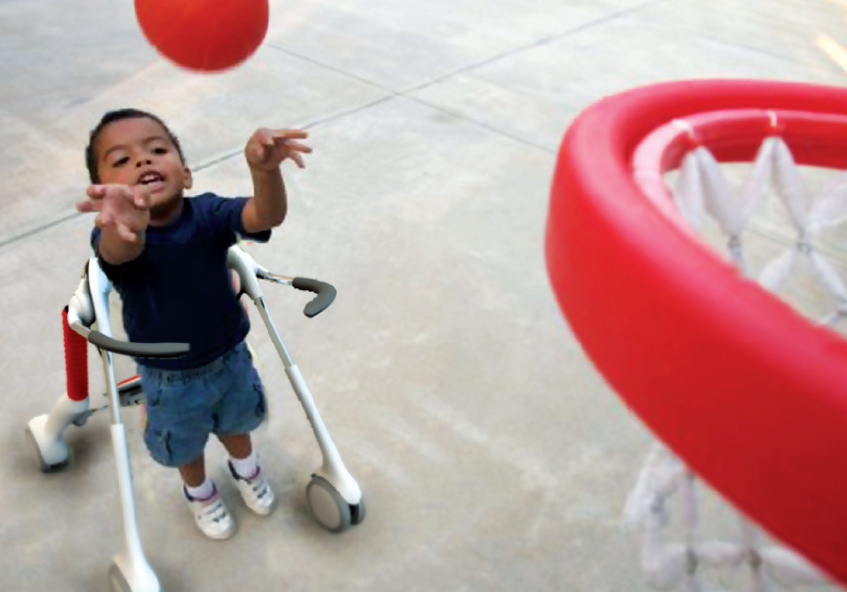
Patients are Human, not Technical Problems
Assistive walkers for cerebral palsied children are often poorly designed - They are cumbersome to use, inconvenient for caregivers, and look ‘painful’. This is the result of viewing patients as mechanical puzzles in need of repair, and forgetting that they are people with feelings.
I designed Leapfrog to create a new system of gait-training support that is intuitive to use and easier to integrate into the life of the child and his family.
I thought it would be good if Leapfrog also had an appeal that would attract unimpaired children to come and play together instead of frightening them away.
Assistive walkers for cerebral palsied children are often poorly designed - They are cumbersome to use, inconvenient for caregivers, and look ‘painful’. This is the result of viewing patients as mechanical puzzles in need of repair, and forgetting that they are people with feelings.
I designed Leapfrog to create a new system of gait-training support that is intuitive to use and easier to integrate into the life of the child and his family.
I thought it would be good if Leapfrog also had an appeal that would attract unimpaired children to come and play together instead of frightening them away.

Elegant Mechanics
An Automatic and Intuitive Gas-Spring Transformation System
An Automatic and Intuitive Gas-Spring Transformation System

Benefit #1: Transformation without Caregiver Intervention
Leapfrog automatically transforms according to the child’s intention to sit, stand and walk - relieving parents from the chore of repeatedly transfering the child between resting stool and walker. Less weary caregivers = more frequent practice for the child.
Benefit #2: Sense of Independence & Self-Esteem Development
Automatic lift assistance - initiated by the child and not requiring caregiver intervention - affords a more positive form of rehabilitation where the child gets to ‘try to do it himself ’ instead of being forced into positions.
Leapfrog automatically transforms according to the child’s intention to sit, stand and walk - relieving parents from the chore of repeatedly transfering the child between resting stool and walker. Less weary caregivers = more frequent practice for the child.
Benefit #2: Sense of Independence & Self-Esteem Development
Automatic lift assistance - initiated by the child and not requiring caregiver intervention - affords a more positive form of rehabilitation where the child gets to ‘try to do it himself ’ instead of being forced into positions.

How Automatic, Intuitive Transformation Works
When sitting, the child’s weight folds the walker into chair mode; When trying to stand, reduced pressure on the seat allows the gas spring to extend, transforming into walker mode.
How Lift Support Works
The gas spring raises the seating surface, and is calibrated to provides the right amount of lift to assist the child’s bottom past the critical mid-point of standing. This force is reduced as the child develops greater control and strength.
When sitting, the child’s weight folds the walker into chair mode; When trying to stand, reduced pressure on the seat allows the gas spring to extend, transforming into walker mode.
How Lift Support Works
The gas spring raises the seating surface, and is calibrated to provides the right amount of lift to assist the child’s bottom past the critical mid-point of standing. This force is reduced as the child develops greater control and strength.
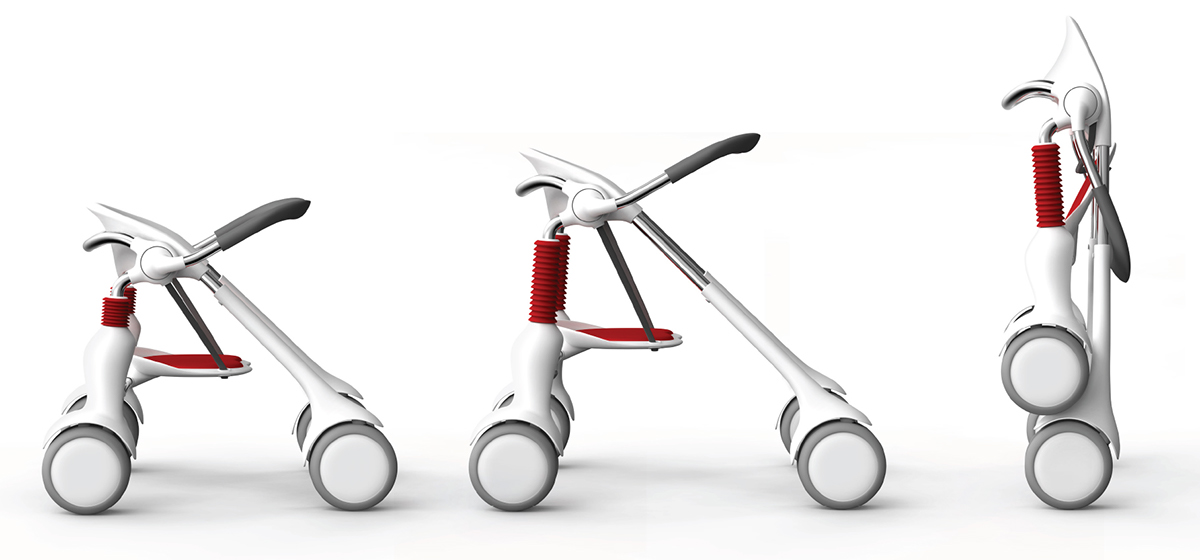
Flexibility: Complex Problems with Simple Solutions
It was a major challenge to simultaneously incorporate size adjustments, flat folding and transformation. Eventually an elegant solution was found, accomodating growth for 11/2 - 5 year-old children.
It was a major challenge to simultaneously incorporate size adjustments, flat folding and transformation. Eventually an elegant solution was found, accomodating growth for 11/2 - 5 year-old children.
Leapfrog Development Process Case Study
Gathering Information & Insight
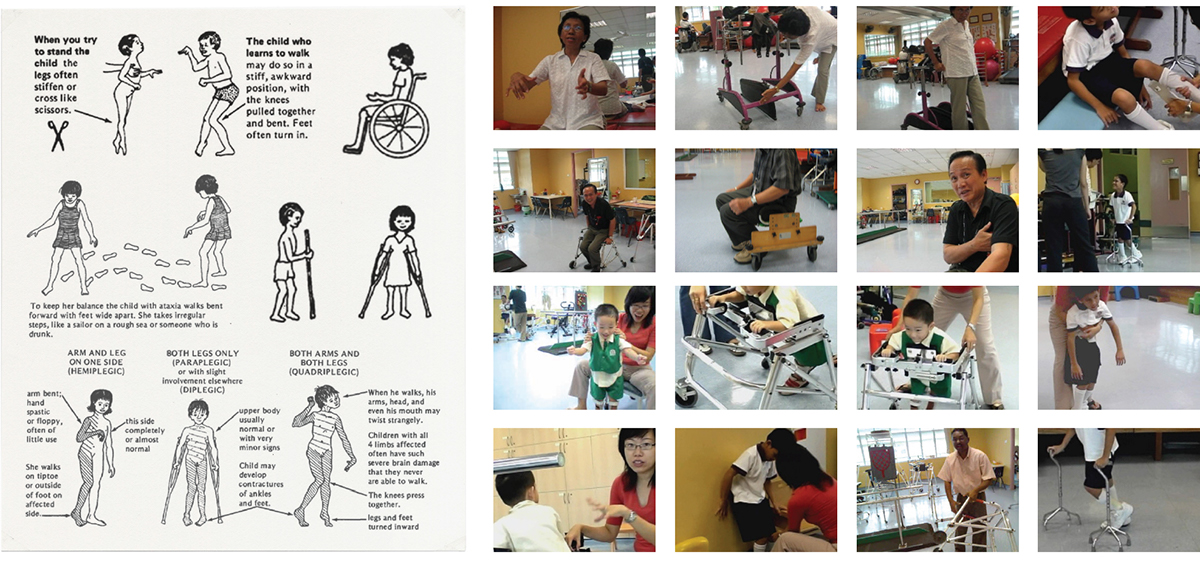
Literature, Field Observation & Hands-on Research
Gathering insights in this specialized field of medical practice required going deep into literature, studying existing devices, interacting with patients, and consulting with therapy and equipment specialists. Most of the useful observations came from hands on participation in rehab sessions.
Gathering insights in this specialized field of medical practice required going deep into literature, studying existing devices, interacting with patients, and consulting with therapy and equipment specialists. Most of the useful observations came from hands on participation in rehab sessions.
Making Sense of the Chaos

Investigation Tools
Various tools were used in the process to organize research findings into usable information. Here, a user-centric map was used to record the observations, gain a holistic view of the problem, and to identify related factors. This helps to ensure more bases are covered and key opportunities are not missed. The map here helped to identify that beyond the patient’s obvious physical needs, his emotional needs and the secondary user (caregiver) are also crucial factors to consider for the design.
Various tools were used in the process to organize research findings into usable information. Here, a user-centric map was used to record the observations, gain a holistic view of the problem, and to identify related factors. This helps to ensure more bases are covered and key opportunities are not missed. The map here helped to identify that beyond the patient’s obvious physical needs, his emotional needs and the secondary user (caregiver) are also crucial factors to consider for the design.
Developing Key Strategies for Leapfrog
Strategy 1: The Importance of Emotional Needs
New findings in physical therapy emphasize the importance of developing the patient’s sense of independence and confidence. Active assistance, where the child is encouraged to ‘try-it-himself’ while being partially supported, is preferred. Conventional equipment approach the child’s condition like a mechanical problem that needs to be fixed, these devices lock them into passive positions, leaving no room for a sense of participation and achievement.
I find myself agreeing with the new approach because it grows the child as a whole person, so this became a key factor in my brief - to support the user’s positive emotional development alongside physical rehabilitation. In the same vein, I added another criteria - I wanted the walker to be of minimal hindrance to communication and interaction with friends and family.
Strategy 1: The Importance of Emotional Needs
New findings in physical therapy emphasize the importance of developing the patient’s sense of independence and confidence. Active assistance, where the child is encouraged to ‘try-it-himself’ while being partially supported, is preferred. Conventional equipment approach the child’s condition like a mechanical problem that needs to be fixed, these devices lock them into passive positions, leaving no room for a sense of participation and achievement.
I find myself agreeing with the new approach because it grows the child as a whole person, so this became a key factor in my brief - to support the user’s positive emotional development alongside physical rehabilitation. In the same vein, I added another criteria - I wanted the walker to be of minimal hindrance to communication and interaction with friends and family.

Strategy 2: The Importance of Secondary Users/Caregivers
Speaking to the parents yielded the most useful information for areas which sorely needed improvement. It became obvious that the ease of use for the caregivers profoundly impacts the frequency of practice for the child. Lower caregiver involvement, easy adjustment and setup, and lightness thus became important factors of the design brief.
Speaking to the parents yielded the most useful information for areas which sorely needed improvement. It became obvious that the ease of use for the caregivers profoundly impacts the frequency of practice for the child. Lower caregiver involvement, easy adjustment and setup, and lightness thus became important factors of the design brief.

Unmet Needs, Opportunity & Positioning Study
The research was further fleshed-out with an in-depth study of existing products on the market - analysing their price, positioning and functionality. ‘Intensive rehabilitation’ type devices seemed plentiful, whereas a device which is more companion-like, with a friendliness and convenience geared towards daily usage at home, appears be more of an unmet need.
This resonated with the earlier insights calling for a product that is more like an assistive companion than a medical tool, and one that is designed with sensitivity to the emotional development of the child.
In terms of functionality, it became clear that a combination stander with gait-trainer device could be a good niche to pursue because there were relatively fewer offerings - most of which did not seem to be very competitive.
The research was further fleshed-out with an in-depth study of existing products on the market - analysing their price, positioning and functionality. ‘Intensive rehabilitation’ type devices seemed plentiful, whereas a device which is more companion-like, with a friendliness and convenience geared towards daily usage at home, appears be more of an unmet need.
This resonated with the earlier insights calling for a product that is more like an assistive companion than a medical tool, and one that is designed with sensitivity to the emotional development of the child.
In terms of functionality, it became clear that a combination stander with gait-trainer device could be a good niche to pursue because there were relatively fewer offerings - most of which did not seem to be very competitive.
Creating the Detailed Brief
The insights and analyses provided the basis to draw up the detailed design brief to guide the development process. This included a few primary aims and secondary criteria, as well as the definition for the appropriate product personality/mood.
The insights and analyses provided the basis to draw up the detailed design brief to guide the development process. This included a few primary aims and secondary criteria, as well as the definition for the appropriate product personality/mood.
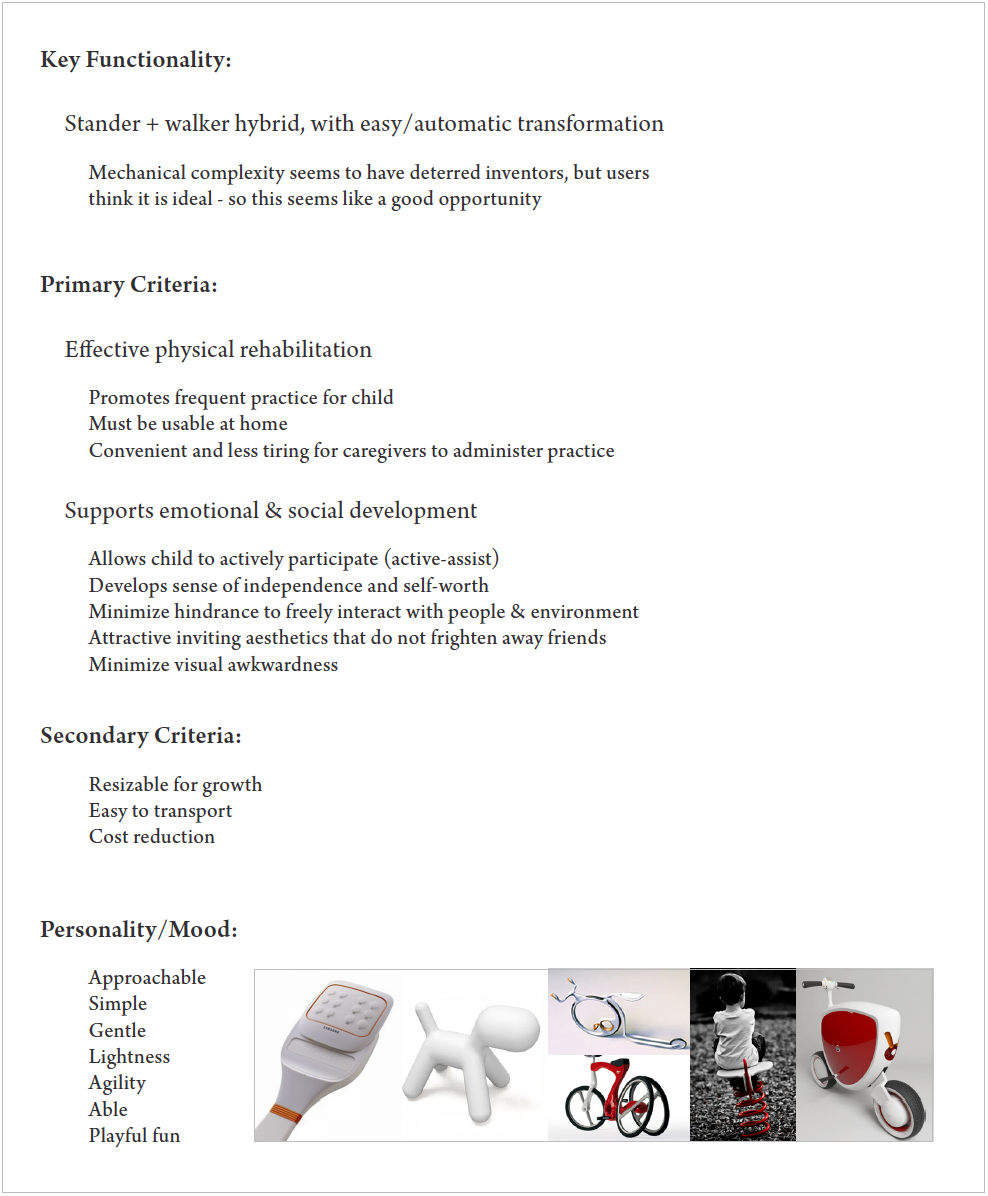
Ideation & Concept Development
Early Sketches
Initial ideas were kept broad, exploring different ways to look at the problem. From baby-walker-esque ideas to exoskeletons to hand-powered go-karts.
Initial ideas were kept broad, exploring different ways to look at the problem. From baby-walker-esque ideas to exoskeletons to hand-powered go-karts.
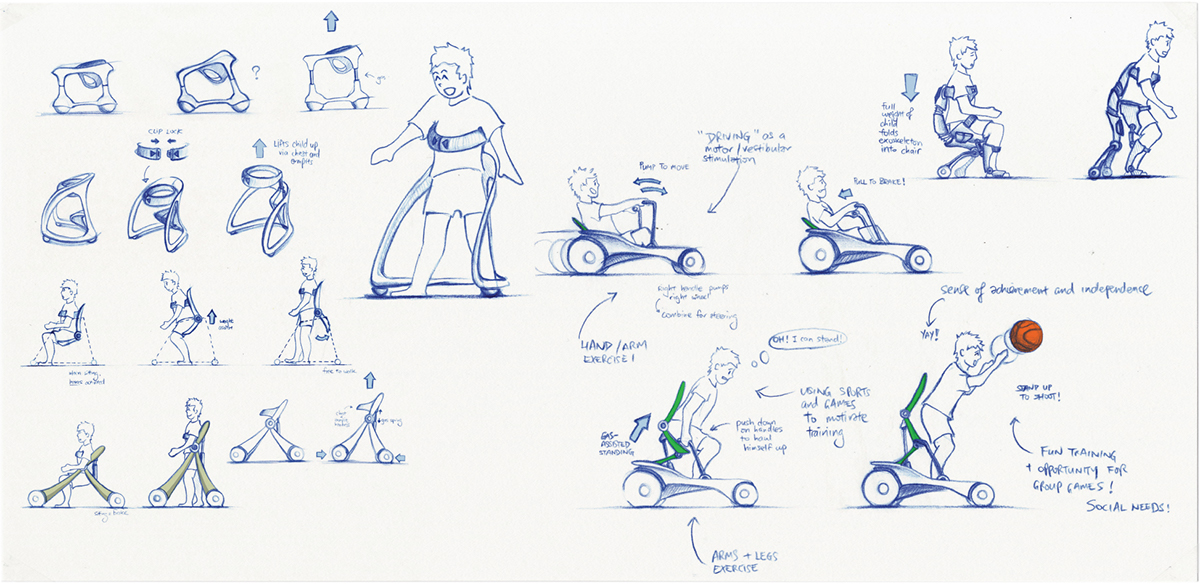
The kart idea showcases a different take on the problem - Although it only caters for standing up (no gait-training feature), it addresses issues of motivation and community interaction through games, while still providing limb-strength training. I believe in an ideation process which starts with broad options because new ways of looking at the problem opens up possibilities to find interesting solutions that might otherwise have been missed by tackling the problem head-on.
Concept Sketches
Promising ideas were developed further into 3 concept directions: The proposals were fleshed out with more realistic ergonomic, usage scenarios, construction layout and preliminary visual language.
Promising ideas were developed further into 3 concept directions: The proposals were fleshed out with more realistic ergonomic, usage scenarios, construction layout and preliminary visual language.

This was the chosen concept direction for Leapfrog
Attempting Sportiness to Counteract Impression of Disability
The selected concept was taken further and exploration was broadened again. I tried a more sporty style to escape the notion of disability. The structures were also thinned down from the early concept to reduce the cage-like feeling. However it still had a ‘technical/engineering’ aesthetic, and lifting the child from the underarms instead of the backside was not ideal.
The selected concept was taken further and exploration was broadened again. I tried a more sporty style to escape the notion of disability. The structures were also thinned down from the early concept to reduce the cage-like feeling. However it still had a ‘technical/engineering’ aesthetic, and lifting the child from the underarms instead of the backside was not ideal.
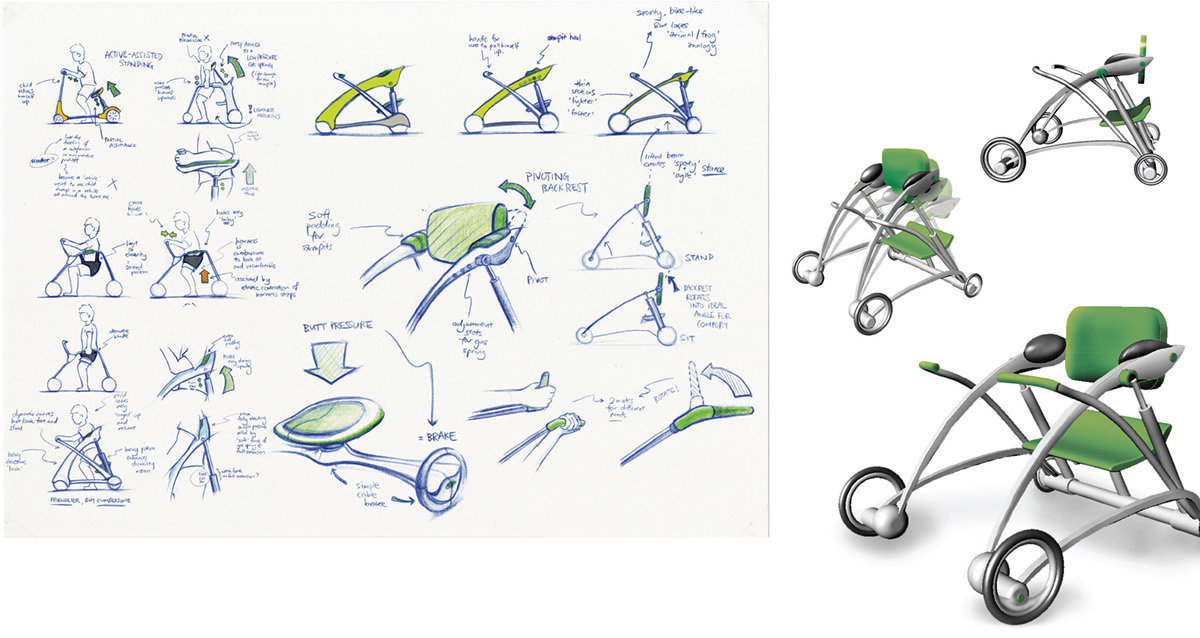
Sketches and quick CAD mock-ups to test concept

The Search for a Language and a Gesture
While trying to solve the mechanical requirements, I was looking for the appropriate first-read impression, and the overall visual personality of the walker. These sketches started to define the proportional balance, stance, and design language of Leapfrog.
While trying to solve the mechanical requirements, I was looking for the appropriate first-read impression, and the overall visual personality of the walker. These sketches started to define the proportional balance, stance, and design language of Leapfrog.
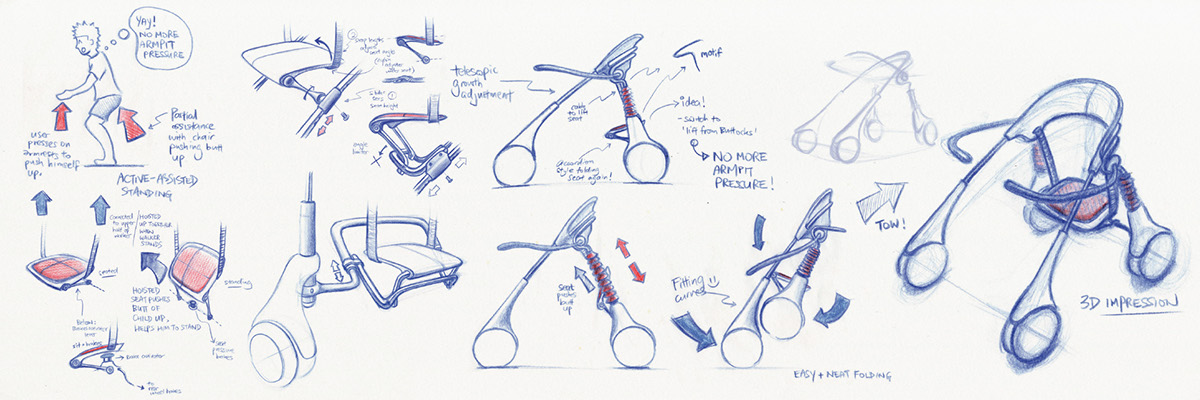
Key Mechanical Development
I figured out a way to eliminate the bottom structural beam. The walker lost its technical aesthetic, and became less cage-like. It looked a lot of lighter and more agile. This also enabled an elegant folding solution. I decided that this was good.
I figured out a way to eliminate the bottom structural beam. The walker lost its technical aesthetic, and became less cage-like. It looked a lot of lighter and more agile. This also enabled an elegant folding solution. I decided that this was good.
Models, Prototypes & User Testing

Rough Models & Mechanical Prototype
Foam, LEGO and structural CAD models were first used to quickly experiment with and verify ergonomics, mechanism layout, folding and growth allowances. After that, plans were drafted to build the functional testing rig.
Foam, LEGO and structural CAD models were first used to quickly experiment with and verify ergonomics, mechanism layout, folding and growth allowances. After that, plans were drafted to build the functional testing rig.

Early Testing & Prototype Modification
The problem quickly became obvious - the seat did not fold as envisioned on sketches, and the walker was therefore unable to transform. It required entirely rethinking the way the seat compresses, and many rounds of prototype modification to finally get it to work - and for the mechanical principle to be refined to a good level of simplicity and clarity.
The problem quickly became obvious - the seat did not fold as envisioned on sketches, and the walker was therefore unable to transform. It required entirely rethinking the way the seat compresses, and many rounds of prototype modification to finally get it to work - and for the mechanical principle to be refined to a good level of simplicity and clarity.

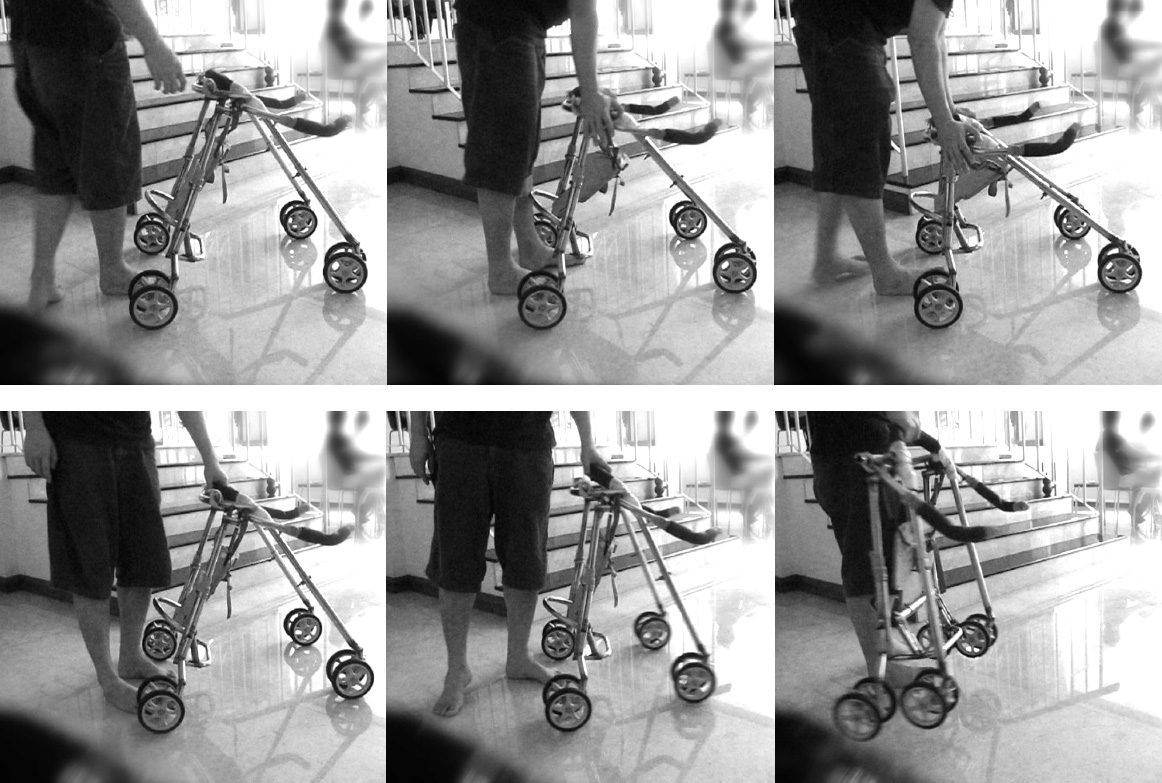
The resultant simple and intuitive sit-to-stand transformation, and convenient single-action folding principle
Proof of Concept
User-testing was carried out with the help of a paraplegic child volunteer at the Singapore Cerebral Palsy Centre. The comparative study of the fluidity of the standing up process, between Leapfrog and the paraplegic child’s own set of crutches, reveals Leapfrog’s smoother and more effortless system, it also proved itself as an adequate walking support. At this stage, Leapfrog was awarded Grand Winner of the prestigious Braunprize in Germany, 2007. The research is on-going to further improve the system and is currently funded by the National University of Singapore for further engineering development towards production.
User-testing was carried out with the help of a paraplegic child volunteer at the Singapore Cerebral Palsy Centre. The comparative study of the fluidity of the standing up process, between Leapfrog and the paraplegic child’s own set of crutches, reveals Leapfrog’s smoother and more effortless system, it also proved itself as an adequate walking support. At this stage, Leapfrog was awarded Grand Winner of the prestigious Braunprize in Germany, 2007. The research is on-going to further improve the system and is currently funded by the National University of Singapore for further engineering development towards production.

With crutches, there was a need to initiate standing by forcefully swinging his body forward to gain momentum. There was also a tendency for the child to repeatedly fall back onto the chair during mid-stand; With Leapfrog, such ‘fall back’ cases did not occur, and the automatic transformation/standing function was significantly gentler, smoother and faster.
Aesthetics & Detailing
The prototype testing led to further modifications in the structural design and proportions. These changes were made concurrently with the final aesthetics refinement and visualized in CAD. Cosmetic mockups were subsequently made via stereolithography.
The prototype testing led to further modifications in the structural design and proportions. These changes were made concurrently with the final aesthetics refinement and visualized in CAD. Cosmetic mockups were subsequently made via stereolithography.
